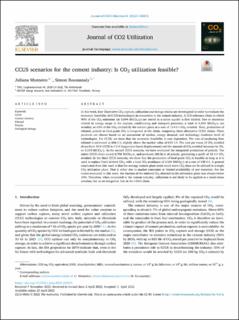| dc.description.abstract | In this work, four illustrative CO2 capture, utilization and storage chains are investigated in order to evaluate the economic feasibility of CCUS technologies in connection to the cement industry. A CCS reference chain in which 90% of the CO2 emissions (or 0,694 MtCO2/y) are stored in a saline aquifer is first studied. Due to emissions related to energy usage in the capture, conditioning and transport processes, a total of 0,504 MtCO2/y are avoided, or 65% of the CO2 emitted by the cement plant at a cost of 114 €/t CO2 avoided. Then, production of ethanol, polyols or food-grade CO2 is integrated to the chain, composing three alternative CCUS chains. These products are chosen based on an assessment of market, energy demand, and technology readiness level of technologies. For CCUS, we show that the economic feasibility is case dependent. The cost of producing blue ethanol is estimated as 656 €/t, slightly above the market value of 633 €/t. The cost per tonne of CO2 avoided drops from 114€ (CCS) to 111€ (sugarcane-based displacement) and the amount of CO2 avoided increases by 3%, to 0,518 MtCO2/y. In the second CCUS scenario, we have evaluated the integrated production of polyols. The entire CCUS chain avoids 0,708 MtCO2/y, and produces 288 kt/y of polyols, generating a profit of 18 €/t CO2 avoided. In the third CCUS scenario, we show that the production of food-grade CO2 is feasible as long as it is used to replace fossil-derived CO2, with a total CO2 avoidance of 0,504 MtCO2/y at a cost of 108 €/t. A general conclusion from this work is that the average cement plant emits much more CO2 than can be utilized in a single CO2 utilization plant. That is either due to market constrains or limited availability of raw materials. For the routes evaluated in this work, the fraction of the emitted CO2 directed to the utilization plant was always below 10%. Therefore, when connected to the cement industry, utilization is not likely to be applied as a stand-alone solution, but as an integrated link in the CCUS chain. | en_US |

